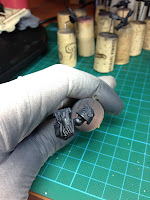I will push through it, but it has meant I skipped my normal Wed night painting session - just didn't feel up to it.
I made a tiny bit of progress over the weekend on my tanks, and about the millionth coat on my Ecanus robes.
Let's start with the highlight - the tanks.
First of all, I messed around with black oil paint, heavily thinned with Mineral Turpentine (White Spirits) to tone the dark green on one of the tanks right down to a very dark green. The intention was to highlight back up to the original dark green and then further up the scale to a bright warm green.
I'm not sure if it was a lack of coats on the original green, or a flawed idea, but it just didn't look right in the end.
Here's some pics:
As you can see, it's practically black! When I started highlighting it was pretty clear it was way too dark; so much so I was too embarrassed to take pictures!
Unperturbed, I continued with my tests on the other tank. First of all, I cut a random shape out of masking tape (a star and a random square thingy), masked the back of the tank and sprayed first green, then white. I didn't take any pics of the final picture, but it did come out perfectly. This means I've proven the method to be effective; so long as I spray the original colour first I prevent any bleed from the new colour through the mask. I did somehow, mysteriously, magically end up with overspray on the other side of the tank! I have absolutely no idea how white paint managed to pass over the top and land on the front of the tank, but I shall mask more carefully moving forward.
Onwards!
Next I experimented with Medium Green highlights. Mixing it 1:1 with thinner, I carefully built up highlights on the edges and top of the tank. I've got to say, the colour and tone was exactly what I was hoping for! I actually expected to need a third colour but have decided against it.
As you can see, I might have gone a little overboard and will try backing off the scale of the transition in future. You can also see where my hand-held mask I used to spray straight line transitions didn't quite work - will need to watch that a lot more carefully in the future.
Overall, though, I'm very happy with the result. It's now ready for edge highlighting in Pale Green, varnish, oil wash and weathering!
On to the lowlight - robes.
I've watched the BuyPainted videos a hundred times, I seriously can't see how the heck he airbrushes the cracks between the folds robes without also covering the highlight area with dark paint. Seriously, it's less than 1mm between cracks! I've literally resprayed test robes over 10 times and I'm giving up at this point.
From now on, I will be spraying a base coat and maybe shadows, but everything else will be highlighted with a brush - the point of the airbrush was to save time, but this has had the opposite effect; it has wasted my time and sucked my motivation down with it.
The only saving grace is I've found a colour pallete I like much better than the previous one; much warmer browns and a more natural transition to the bone\sand primary colour. Unfortunately I don't have the paint names on me, so will have to update it later.
Anyways, will probably paint next week now, will have another update then. Until then, have fun painting, and avoid breathing aeresolised turps!





















































